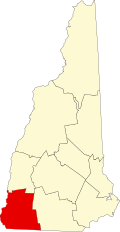Description and history
The Eli Morse Farm is located on the south side of Lake Road, extending southward from the outlet of Dublin Pond at its southwest corner. The property is more than 200 acres (81 ha) in size, including areas of both open fields and woodlands. The main house is a large Federal style brick structure built c. 1822 by Eli Morse's son Thaddeus. Additions were made to the house in 1886, including a porch and front portico. The farmstead includes several outbuildings, including a barn, grist mill, and several cottages. [2]
This land was settled in 1764 by Eli Morse, one of Dublin's first permanent settlers. Morse served as a clerk of the community and left an invaluable record of Dublin's early history. His son Thaddeus, who built the house, was also active in civic affairs, serving as town selectman and in other offices. His son, Thaddeus Jr., opened the house as a boarding house for summer guests in 1857, one of the first such uses of an agricultural property near Dublin Pond. Morse's heirs sold the property to Mrs Sarah Peele, and the property has remained in the hands of her descendants since then. [2]
The farm is also notable as the summer estate of New York City lawyer and diplomat Grenville Clark, who acquired the property after marrying a Peele granddaughter. Clark organized a peace conference in 1945, held at this site, at which attendees drafted the Dublin Declaration, calling for the United Nations to be created as a world government. The Clark family continues to own the property, maintaining for agricultural and conservation purposes. [2]
This page is based on this
Wikipedia article Text is available under the
CC BY-SA 4.0 license; additional terms may apply.
Images, videos and audio are available under their respective licenses.



